Cleaners min. Soviet mine trawls 1932-1945 (part of 2)
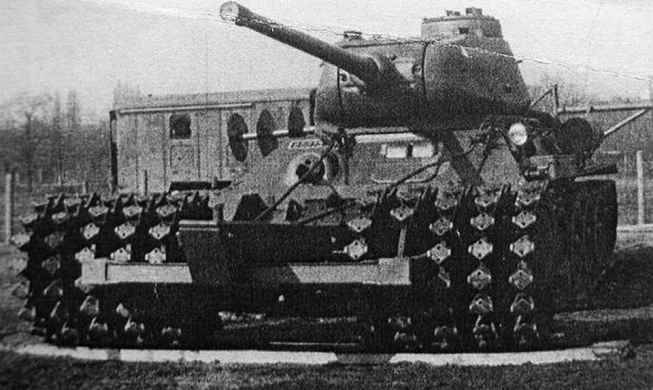
Part two. Historical
Tank trawl - a type of mine trawl, attachments of a tank, armored tractor or a specialized vehicle that is designed to overcome or clear anti-tank minefields
FIRST SOVIET SHOOTER WAXES
After World War I, where mines were used for the first time (albeit primitive in design), the question arose of developing a special tool that would minimize the effect of minefields on the pace of advancement of troops and reduce their losses. And the tank anti-mine trawl became such a means - a new type of weapon that was mounted on armored vehicles.
Work on the creation of mine trawl in the USSR was started in 1932 - 1934. in accordance with the “Engineering Armament System”, which was approved in 1930. This document established a list of military engineering equipment needed to support military operations of troops, determined their main tactical and technical requirements, the procedure for developing and adopting weapons. Among the types of engineering technology was a group of so-called sapper (engineering) tanks. It included tanks and minesweepers, designed to identify and overcome minefields.
During this period, the teachers of the Military Engineering Academy E. Grubin, N. Bystrikov and others developed and experimentally tested various mine-trawling structures: knife, impact (pitch, chain) and roller. All trawls were rutted and trawled a strip of terrain directly in front of the tank track by initiating mines (impact and roller) or digging mines and moving them to the side (knife).
The first samples of a knife trawl were created for the T-26 tank in October 1932 in Leningrad. The tank received the ST-26 index (the sapper T-26 tank). The trawl consisted of two separate sections. Each section was mounted on a special bearing that could drop a trawl from a tank in emergency situations. The trawl, fixed on the tank, was transferred to the combat position by lowering, and into the transport position - by raising the sections. The machine gunner supervised this process without leaving the combat vehicle. But on tests, the trawl showed unsatisfactory results: the trawls had low resistance to explosions, knives when hitting hard objects broke or deformed, the trawl worked poorly in frozen areas and in areas that were overgrown with bushes and the like. The trawl was not accepted for service.
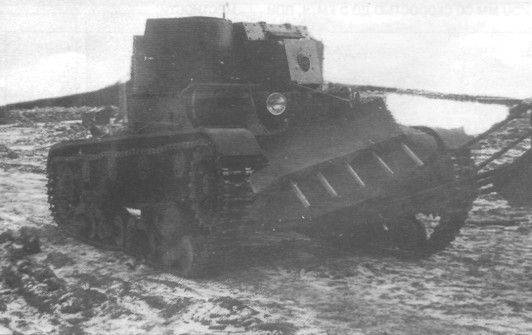
During the 1932-1933. Three samples of a knife-type mine trawl were tested at the site of the Red Army checkpoint.
The transfer of all trawls from the traveling to the combat position was carried out without leaving the crew from the tank. Emergency uncoupling and turning the tank when moving in a combat position were impossible.
The working bodies of the knife trawls were not explosion-proof, and when hitting solid objects the knives broke or deformed so much that they lost their working capacity.
All three variants of the knife trawl on tests showed unsatisfactory results and were not accepted for service due to a number of shortcomings:
- the impossibility of trawling mines in hard and frozen soils and in areas overgrown with shrubs;
- impossibility of maneuvering the machine when mines are being tracked;
- insufficient structural strength of the frame and rapid wear of knives;
- low speed of movement of the tank with a trawl;
- Slapping knives into the ground or spontaneous release from the ground.
The presence of defects of a fundamental nature, identified during the tests, led to the cessation of further work on the knife-type tram.
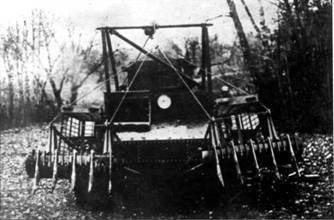
In November, 1934, much earlier than the British, in Leningrad, under the command of B. Ushakov and N. Zeitz, a draft trawl was developed for the BT-5 tank. Its design has already provided a continuous trawling of mines before the front projection of the tank. In 1937, the continuous trawling of mines for the BT-7 tank was developed. The design of the trawl ensured continuous trawling in the 3,5 m band at vehicle speeds up to 8 km / h.
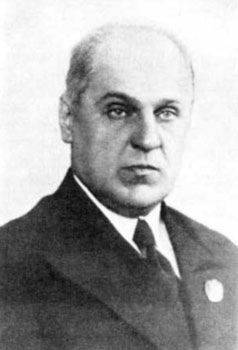
In 1936, several samples of impact type trawls that were installed on T-26 tanks were developed and tested. The trawl was attached to the front of the tank and consisted of a metal frame on which the drums were mounted - two opposite each track. The drums were driven from the leading (front) wheels. The drums were attached with cables in a certain order 55 percussion (working) elements. During the rotation of the drums, work items hit the ground and thus caused mines to be blown up.
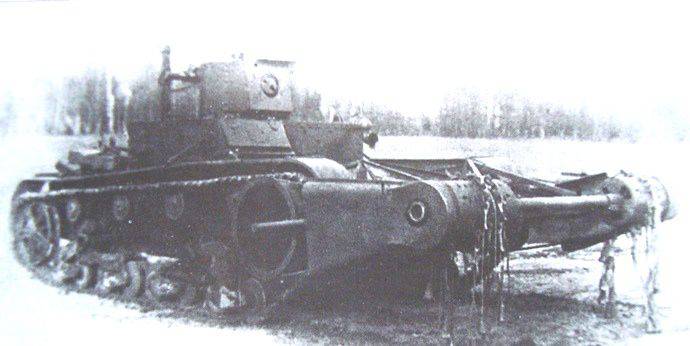
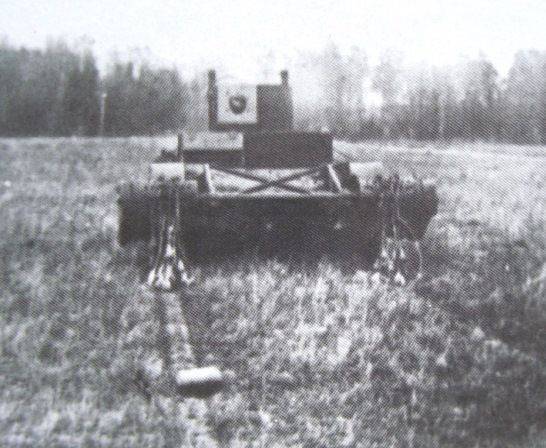
In July - August, the 1936 passed the test of a continuous mine trawling mine sweep for the medium tank T-28 (TR-28). It was developed by the engineers of the design bureau of the plant No. XXUMX I. Belogurtsev and A. Kaloev and provided for the mines to be tracked in front of the tank in an area of width 185 m.
Boikovy trawl had a drum, on which in a certain order were located the strikers, suspended on cables with a diameter of 10-12 mm. When the tank was moving, the drum was rotated using a chain drive from the tank guide wheel. For this purpose, two sprockets were installed on the side of the guide wheel: one (small) - for chain drive, the second (large) - to engage the track tracks of the track and to prevent the guide wheel from slipping. Trawling speed was 10-15 km / h. The trawl was not accepted for service.
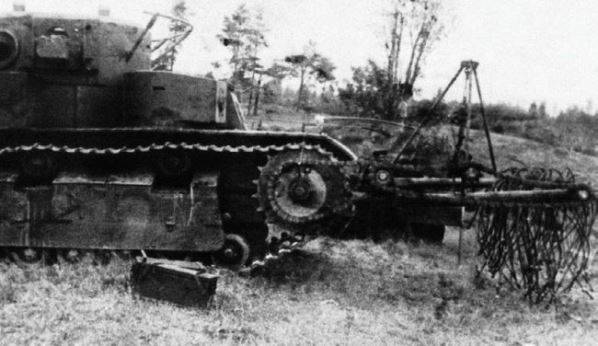
The main drawbacks indicated in the report of the commission were: the separation of 7 — 8 working elements during the detonation of mines, which violated the subsequent effective work; tangling during the operation of the cables, which led to the omission of mines and the formation of a cloud of dust, dirt or snow during the work ahead of the tank, which led to a loss of orientation by the driver-mechanic.
Subsequent work on the aforementioned trawls was stopped.
As the main type in the Red Army, the roller trawl was adopted as the most effective. The first sample of the trackline trawl was designed in 1935. After tests and improvements in 1937, prototypes of roller trawls for T-26 tanks (CT-26) were made, and in 1938 for T-28.
The trawl was attached to the tank ST-26 with a special frame, consisted of two sections and had a special winch for raising the trawl to the transport position. Each section of the trawl consisted of three rollers. Each roller was free to rotate on a common axis and did not depend on the other two. This made it possible to better copy the irregularities of the terrain and, thus, improve the trawling procedure.
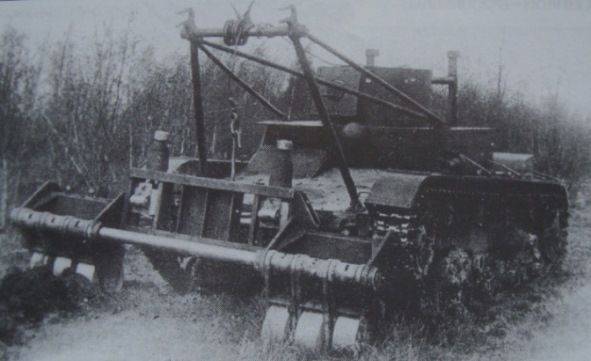

Despite the low weight (1,8 t) and good spring damping, the trawl had certain drawbacks: low overall resistance to demolition, and the rollers themselves had to be changed after three explosions.
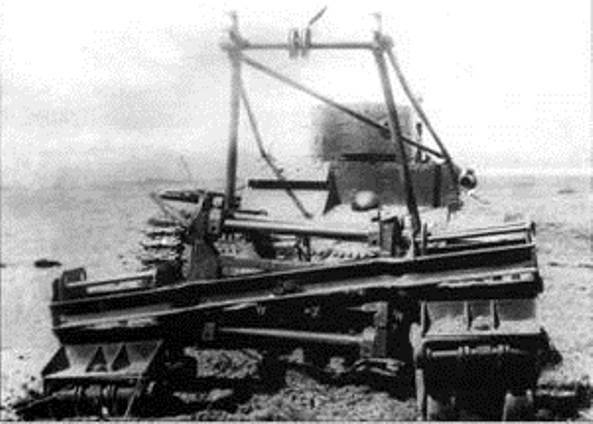
The roller trawl for the T-28 tank was developed at the NATI plant in Moscow in 1938, the test took place in May-June 1939. Tral could be mounted either on the T-28 linear tanks or on the engineering tank 28 without processing the hull cars. After the tests were carried out, it was recommended by the military to increase the survivability of the trawl to 10 — 15 of explosions under the section (instead of 2 — 3) and to improve the maneuverability of the tank with the installed trawl. It was decided to test the upgraded samples in the summer and winter of 1940.
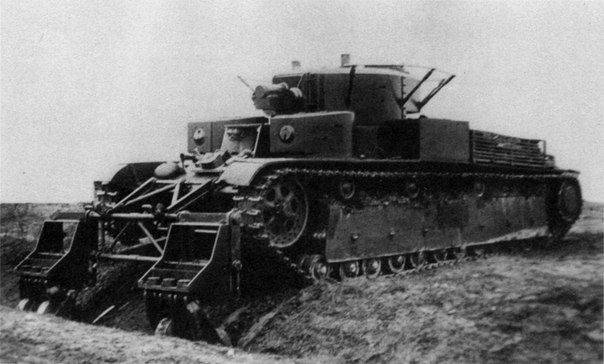
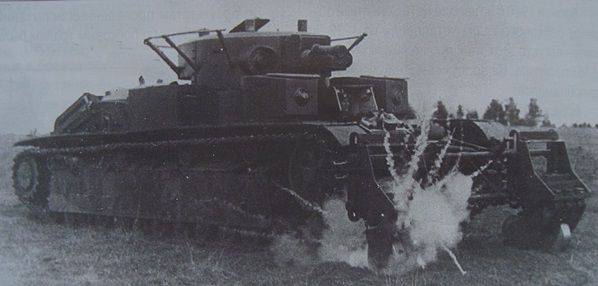
With the beginning of the Soviet-Finnish war, an acute need arose for various engineering means, and first of all, in mine trawls. Leningrad plants №185 them. Kirov and №174 them. Voroshilov already in December 1939 produced the first samples of trawls. Later they made a series of disk mine trawls in the amount of 142 pcs. (The 93 trawl was manufactured by the Kirov Plant and 49 Plant No. 174 named after Voroshilov). Trawls entered the active army in February-March 1940 g. Despite the slight resistance to detonation (after the first explosion the mines were bent), the trawls were successfully used in the 20 and 35 tank brigades and tank battalions of the 8 army.
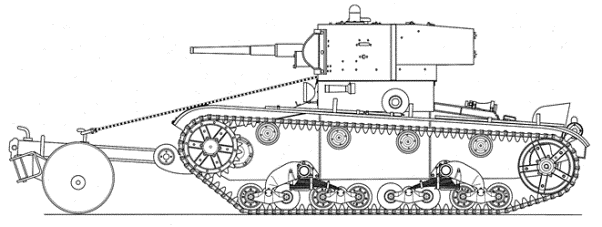
An interesting electric tanker project was developed in October 1940 in the SKB-2 of the Leningrad Kirov Plant. Its authors were O. Serdyukov and G. Karpinsky. In April, 1941 was made the layout of this machine. Subsequent work terminated.
The project involved the installation of special electrical equipment for the base of the KV-2 production tank. The dynamo machine, using an antenna that was outside in front of the hull, created an electromagnetic field that, at a distance of 4 - 6 m from the tank, caused the mines to blow up with electric fuses or electric detonators. The installation was tested on 14 on April 1941 and confirmed the possibility of mines being blown up in this way. Also on the minesweeper was provided equipment for transportation, dumping and remote blasting of explosive charges weighing up to 1 t (the British would only approach such a scheme for the destruction of fortifications during 1944 during the preparation of the landing operation in Normandy).
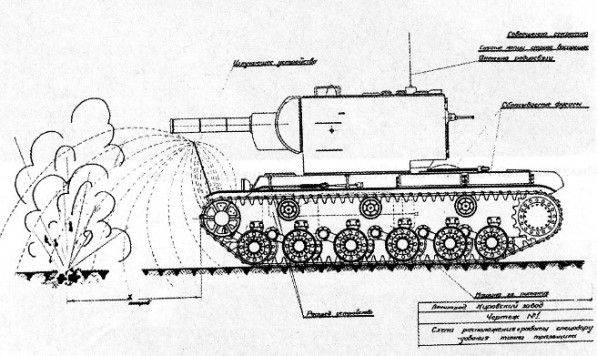
Subsequent tests and experience of the Soviet-Finnish war showed the advantages of the roller trawl, set other requirements for the mine trawl and allowed to finally form its overall appearance.
Unfortunately, all types of mine trawls to the beginning of World War II remained at the level of prototypes. They did not enter the troops.
IN THE YEARS OF WAR
Since the beginning of the Great Patriotic War, the main way to overcome the minefields or arrange the passages in them was the manual method. But he demanded a lot of effort, considerable time (especially at night) and was accompanied by large losses of sappers. In addition, in some cases, work on the equipment of passages in minefields could be noticed by the enemy, as a result of which the attackers lost the element of surprise (as happened on the Kursk Bulge with German sappers). Therefore, with the beginning of the war, work on the development of mine trawls continued, but at an accelerated pace. In the first year of the war, several types of roller disk trawls were developed.
The first of these was a hitch to a tractor or tank and consisted of 17 welded discs on which special spurs were attached to improve the trawling process. Copying the terrain was provided by a gap between the axis and the hole of the disk. A prototype of such a trawl was made in Leningrad.
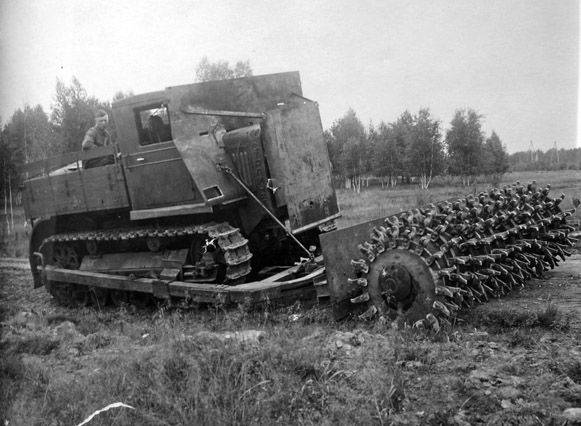
The second similar trawl was designed at the Dormashina plant in Rybinsk. It consisted of a frame and eight discs that were planted on a common axis. But none of these trawls into service were accepted because of their heavy weight and low resistance to explosions.
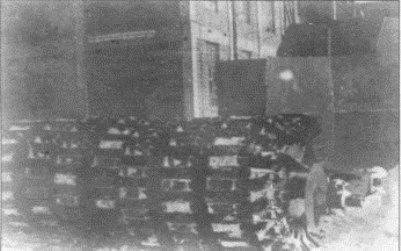
At the beginning of 1942, work was continued on the mine trawl PT-34, which began as early as 1941, and in August of the same year they were to begin their mass production. In 1941, due to the retreat of the Red Army and the relocation of industry, work on the trawls was suspended. They recalled them at the end of the Moscow battle, where German anti-tank mines caused very significant losses in a number of tank divisions.
Trawl was developed in two versions. Trawl construction D. Trofimov was a cheap two-section design, where the rollers were made of reinforced concrete.
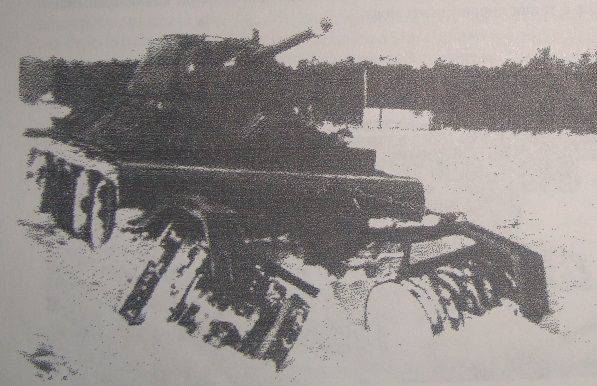
At the trawl of the teacher of the Military Engineering Academy of Colonel P. Mugalev, the trawl body was made of rollers assembled of stamped discs with special steel or cast iron shoes mounted on them. In the spring of 1942, work on the trawls was continued.
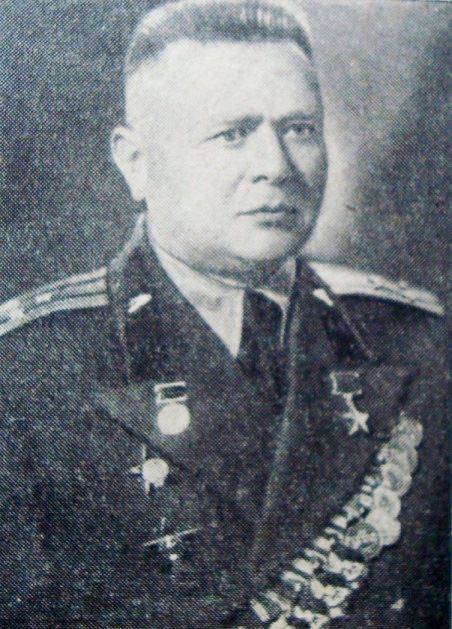
In May, 1942 produced three tank mine trawls, two of which were designed by D. Trofimov and P. Mugalev. The third trawl was constructed from the support rollers of the T-34-76 tank, but due to the high price and heavy weight it was not allowed to be tested. According to the test results, the following conclusions were made: D. Trofimov’s trawl showed inefficiency in trawling, especially in winter. Rollers of wide shape poorly immersed in snow and did not work sufficiently on pressure covers of mines. Trawl P. Mugaleva was more reliable and simple. It was recommended by the State Commission to redo the Mugalev trawl from a three-section into a two-section trawl and adopt it.
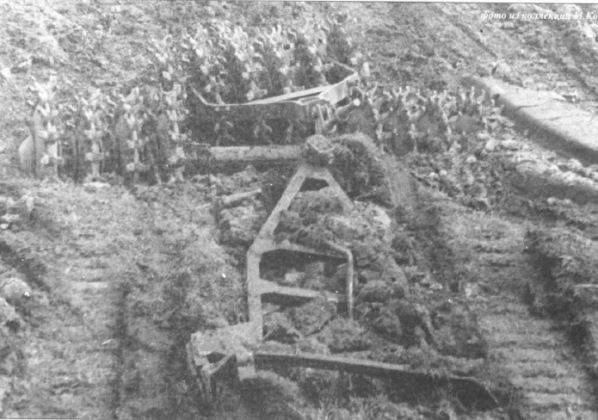
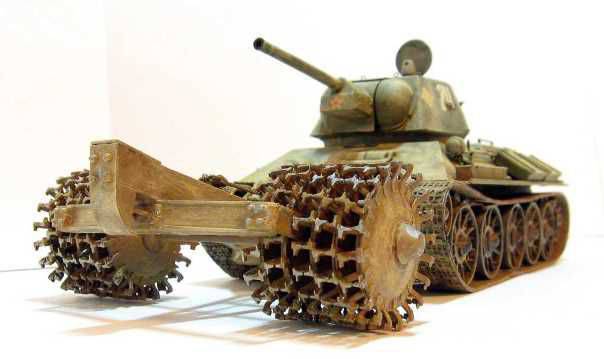

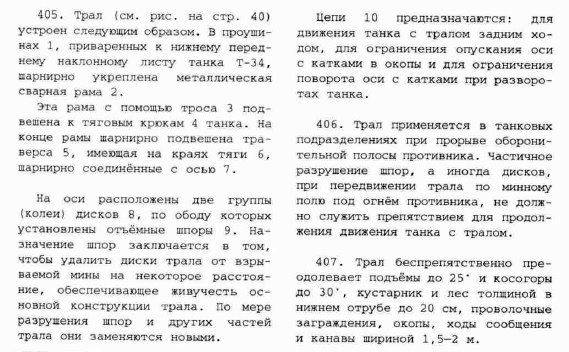
In the summer of 1942, under the brand PT-34 (anti-mine trawl for the T-34 tank), it was put into service, but the start of serial production was delayed until the autumn of 1942. In the fall, the trawl was again upgraded to be installed on all types of heavy and medium tanks and after regular tests in March 1943, began its release under the symbol PT-3 at the Tula machine-building plant "Komsomolets".
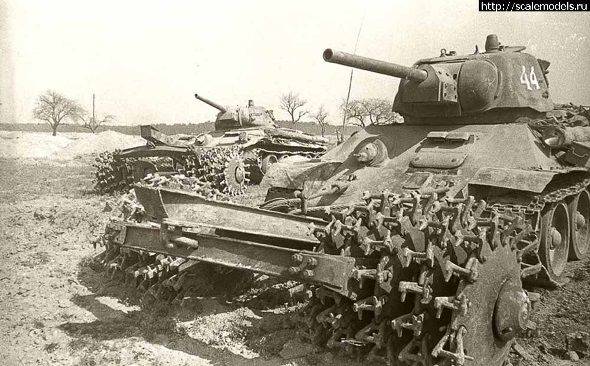
The total weight of the trawl PT-3 was 5300 kg; trawl length - 2870 mm, width - 3820 mm; trawling speed - 10 — 12 km / h. Trawling width - two gauges for 1200 mm. Time of installation of the trawl by the crew - 60 min. Emergency dumping from the tank, unfortunately, was not provided. Trawl PT-3 withstand explosions from 3 to 5, after which repair or its complete replacement was needed. He was easily versed in field conditions for repair and transportation. The shipment was carried out on two ZIS-5 machines or one Studebaker US6 machine.
Trawls easily climbed up to 25 ° and slopes to 30 °, shrubs and single trees with a bottom cut thickness to 20 cm, wire barriers, trenches, communication lines, ditches up to 2,5 m wide and vertical walls to 0,6 m. snow cover thickness up to 0,4 — 0,5 m.
Intractable obstacles to the trawl were: wetland, large fragments of stone walls, trees thicker than 20 cm, moats and funnels wider than 2,5 m wide, scarp with wall height more than 0,6 m and terrain with a sharp transition from descent to ascent and back.
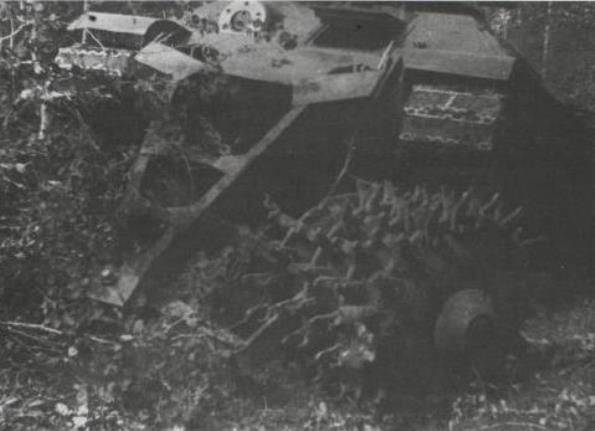
The trawl is arranged as follows: in the cast-design lugs welded to the lower forward inclined armor plate of the tank hull, the metal welded frame of the trawl is hinged. Fastening is carried out with the help of inserted cylindrical fingers with cotter pins. The trawl frame of the cable suspension is kept suspended in front of the tank. At the end of the frame, the traverse is hingedly hinged, through the expansion pipe of which the trawl axis passes. On the axis with a large gap sit ten trawling disks, forming two sections. Free landing of disks on an axis causes copying of small roughnesses of the district. The stable position of the discs when the trawl is moving across the terrain is ensured by the shoulders of the spacers. Spacer sleeves are also placed on the trawl axis. Each perimeter disk is equipped with trawling spurs, which have the purpose not only to transfer pressure to the mine drive, but also to increase the stability of the disk body against the explosion of a mine. With the explosion of a conventional anti-tank mine, the 3 — 4 spurts fly off, which somewhat reduces the reliability of the trawling. As the individual parts of the trawl (spurs, spacers, discs, etc.) are destroyed, they are replaced with new ones. The reverse chains are designed to support the movement of the tank-minesweeper in reverse, to limit the lowering of the axle with rollers in the trenches and to ensure the rotation of the tank-minesweeper.
The design of the trawl PT-3 collapsible. Its installation on any linear medium tank and dismantling can be carried out in field conditions by the crew of the tank, and without the use of special lifting means.
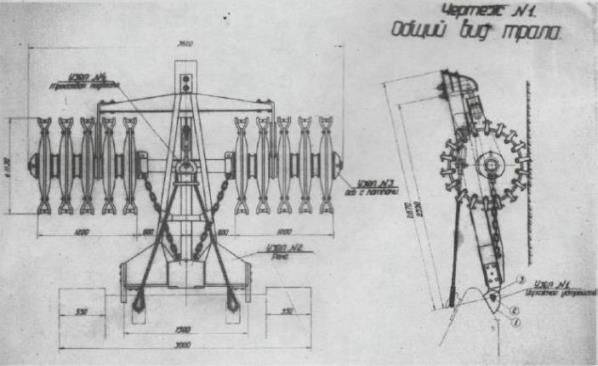
Along with the PT-3 during the Great Patriotic War, other designs of trawls were developed and tested. The experimental model of the explosive trawl, which was a special adaptation to the tank, deserves attention. It consisted of a cassette and ten charges of 5 kg each. When the tank was moving, the charges were ejected from the cassette on the minefield alternately at a certain interval and exploded, forming a passage. However, due to serious design flaws, this trawl was not accepted for service.
The ending should ...

Information